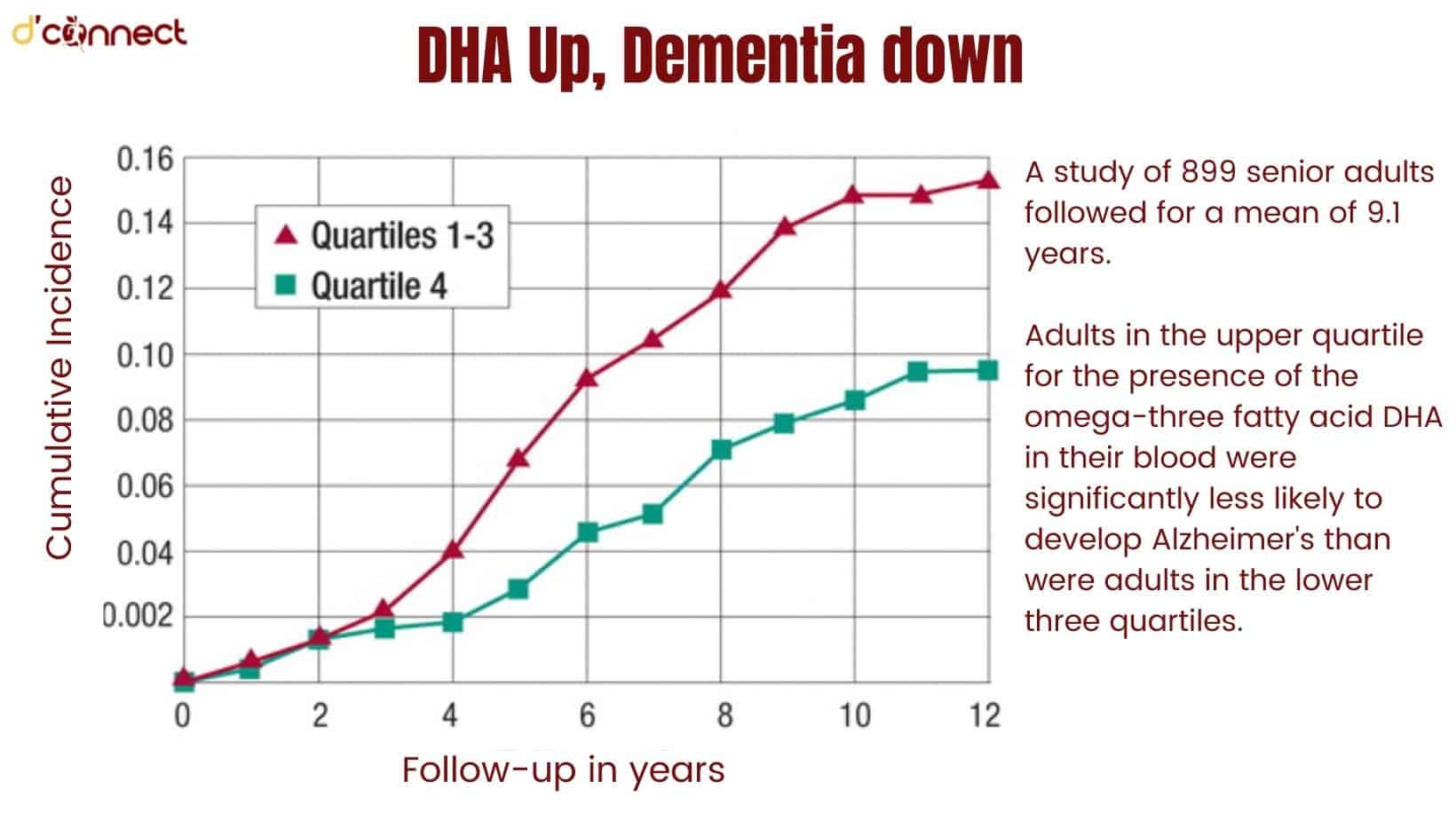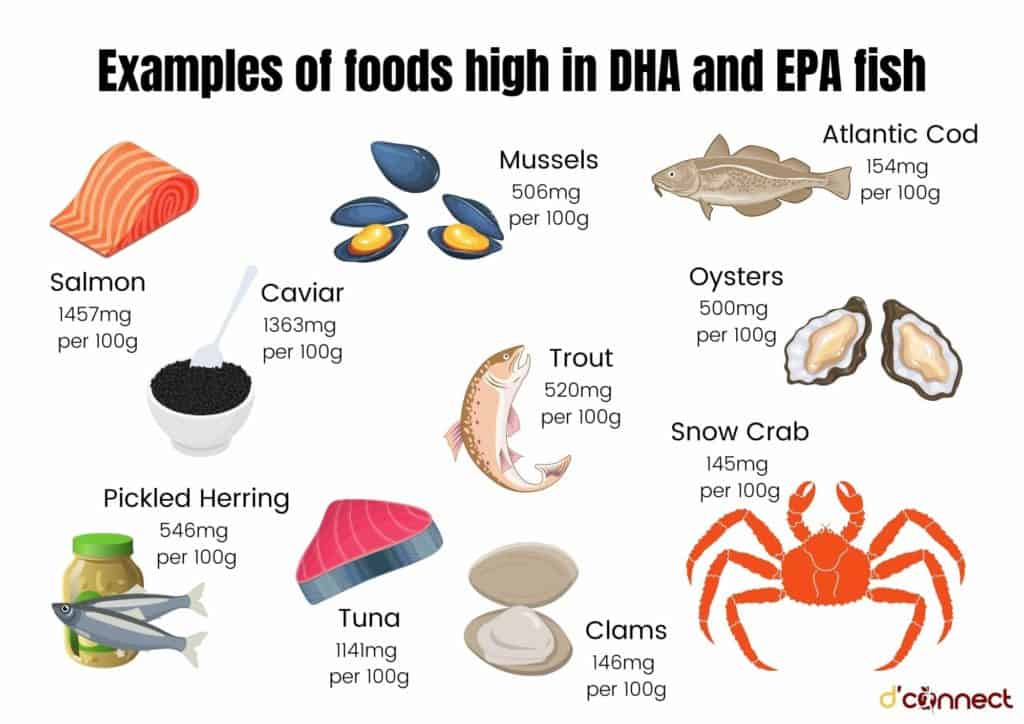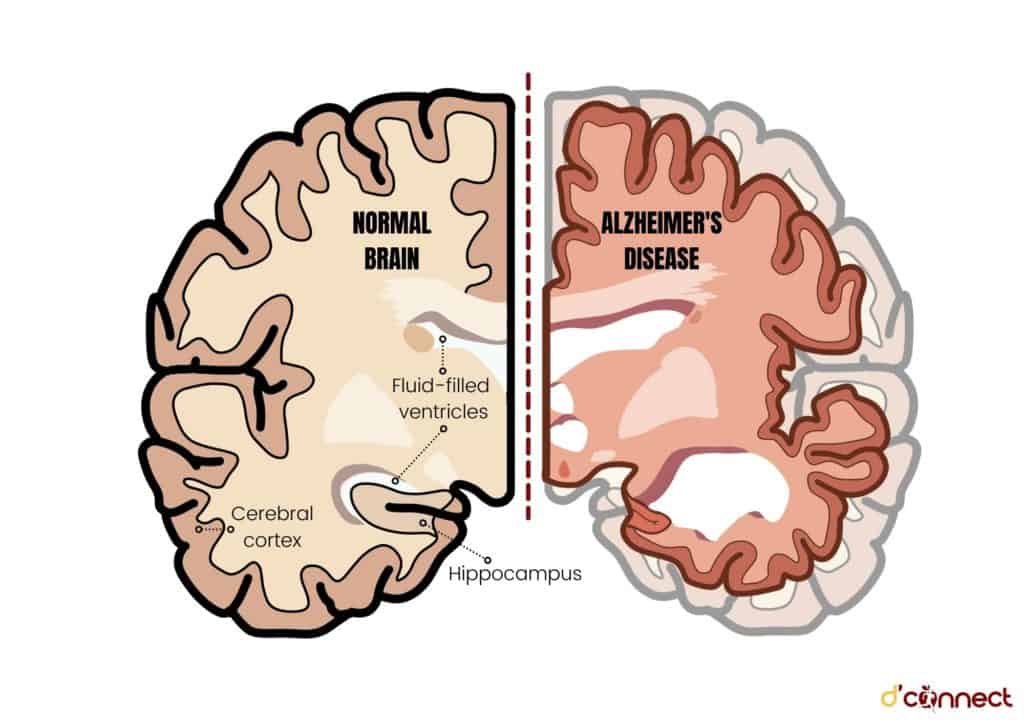
Tiana Hape-Cramond
(Associate Registered Nutritionist)
Note — The article was checked and updated September 2023.
The primary concern with fat intake is the potential risk it poses for heart health, body weight and other markers of health.
Our brain needs fat for proper growth and development and it thrives on certain types of fats, especially fats that are essential and our body cannot make them.
Before we get into “good” and “bad” fats, let’s first understand the connection between our brain and fat.
Brain and Fat
The brain is one of the most complex organs in our body and has many important roles that help the body to function. These functions include controlling other organs, muscles and motor skills as well as our thoughts, memory and vision.
Although there are exercises for the brain, the brain is an organ that contains no actual muscle except the muscle tissue that is within the middle layer of the arteries (in the brain) that carry blood.[1]
The brain is composed of cells, nerve fibres, arteries and arterioles, and is approximately made up of 60% fat.[2]
Fat is an important part of maintaining proper brain function. These fats come from our diet and are incorporated into the membranes of the cells in the brain.[3]
Docosahexaenoic acid (DHA) and Arachidonic Acid (AA) are the fatty acids that make up over 30% of the grey matter of the brain and have the highest concentration in the synapse of the neurons that aid signal transduction.[4]
DHA is an essential fatty acid that is important for the development of the visual cortex, retinal and frontal cortex.[5]
The need for fat begins before birth when the fetal brain is forming. After the brain becomes fully formed (after the age of 5) it still requires DHA to maintain brain function. The frontal cortex, where decision making and controlling judgement occur, and where the most DHA can be found, is still developing between the ages of 5 and 25.[6]
DHA and AA make up over 30% of the grey matter
This means that during this period there is an essential need for essential fatty acids to aid the development of the brain. Apart from the need for fat during the brain development in children, fat intake is also important in older people.
For growing brains, eating “good” fats can improve function and maintain brain health.
Brain Performance and Good Fats
Fats such as monounsaturated and polyunsaturated fats are known as good fats because they have shown improvement in reducing the risk of cardiovascular disease as well as several other health benefits.
Improvements in cognitive function and brain health can be observed with high consumption of monounsaturated fat and polyunsaturated fat.
Brain and monounsaturated fats
Monounsaturated fatty acids are fat molecules that have one unsaturated carbon bond. International recommendations for monounsaturated fatty acids vary between 12-25%.
The New Zealand Ministry of Health recommendation of monounsaturated fatty acids intake is between 10-20% of excess percent of energy.[7]
Monounsaturated fats can be found in:
- Olive oil
- Nuts
- Avocados
- Canola oil
- Peanut oil
- Safflower oil
- Sesame oil
Most of the beneficial effects of monounsaturated fatty acids are linked to the cardiovascular system but there many benefits recorded for the brain function as well.
A study conducted by University of Illinois found that monounsaturated fatty acids are linked to general intelligence and this is due to the relationship between monounsaturated fatty acids and the organisation of the brain’s attention network.
This study included 99 healthy older adults. The authors of this study suggested that there are cognitive benefits of the Mediterranean diet, as this diet is rich in monounsaturated fatty acids.[8]
Another study, performed on mice, looked at the effect of unsaturated fatty acids and neuron function. This study used a canola oil-based diet that is rich in oleic acid and found that increased oleic acid provided a beneficial cognitive effect.[9]
A qualitative review researched the literature linking dietary fat consumption to risk of developing dementia. This review concluded that cholesterol and blood-brain barrier function are involved in the neuropathy of Alzheimer’s disease linking monounsaturated fatty acids to slower age-related cognitive decline.[10]
Brain and polyunsaturated fats
Polyunsaturated fats (PUFA) are fat molecules that have more than two double bonds between the carbon and hydrogen chain. PUFAs can be divided into two groups omega-3 and omega-6.
Omega-3 is essential for body cell function and includes EPA and DHA. Omega-6 is an unsaturated fat that regulates genes and immune health and includes linoleic acid and arachidonic acid.
The differences in these PUFAs are the length of their carbon chain and position of the double bonds which gives them different properties and functions in the body. PUFAs are considered essential fatty acids because they can not be made in the body and must be consumed through diet.
PUFAs are required for brain function and cell development.
Omega-3 includes DHA and EPA
Recommendations for PUFA from the NZ Ministry of Health ranges between 6-10% of energy.[7] There is a separate recommendation for DHA and EPA long chain n-3 PUFA due to the positive effect these fats have on cardiovascular health. This recommendation is 610 mg for men and 430 mg for women which is equivalent to 2 servings of oily fish a week.
Docosahexaenoic acid (DHA)
DHA is important for growth and fundamental development of the brain in infants and is also required for maintenance of brain functions in adults. The decreased DHA in the brain was associated with cognitive decline and with onset sporadic Alzheimer’s disease.
Consuming foods high in DHA are beneficial for brain function and improving learning ability and development of the brain because DHA is involved in cell signalling and is the predominant structural fatty acid in the grey matter of the brain. DHA has been reported to prevent and treat senile dementia.[11]

The high level of DHA in the brain and nervous system are important in infancy and the early years of childhood for brain development and function such as learning ability and memory. A benefit of omega-3 is the role of aiding the brain to repair damage by promoting neural growth.[12]
Eicosapentaenoic acid (EPA)
Eicosapentaenoic acid is the omega-3 acid that is important for producing signalling molecules called eicosanoids which have important roles in physiological processes and reducing inflammation.
An animal study on mice found that adding lysophospholipid EPA in the diet can increase EPA in the brain. This study demonstrated that the form in which EPA is ingested is important for the amount of EPA that can be used in the brain.
DHA and EPA are known to have anti-inflammatory effects that protect against some neurological diseases. Boosting EPA levels in the brain has been shown to be effective in treating and preventing depression.[13]
RELATED — Introduction to: Depression
A study involving patients with Huntington’s disease found that those treated with the placebo had lost cerebral tissue compared to the patients given EPA supplements.[14] This means that a deficiency in EPA can cause health issues.

Examples of foods high in DHA and EPA are fish including:
- Salmon – 1457mg per 100g
- Caviar – 1363mg per 100g
- Tuna – 1141mg per 100g
- Pickled herring – 546mg per 100g
- Trout – 520mg per 100g
- Mussels – 506mg per 100g
- Oysters – 500mg per 100g
- Atlantic cod – 154mg per 100g
- Clams – 146mg per 100g
- Snow crab – 145 mg per 100g
Brain benefits of Good Fats
Improved memory
Healthy fats include precursors for DHA and EPA which are essential fatty acids. These fatty acids are known to increase brain function and memory.[8]
Fetus growth and development
The brain is made up of fats. These are important for growth and development and essential for fetus growth as DHA is required for the structure of membranes used for the central nervous system.[15]
The fetus receives these essential fatty acids from the maternal diet and have been shown that higher DHA levels in pregnant women lead to having babies with better problem solving skills at the age of 1.[16]
Decreased risk of Alzheimer’s disease
With healthy fats contributing to improved memory and the development and maintenance of the brain, it also makes sense that DHA and EPA are attributed to decrease the risk of developing Alzheimer’s Disease.[11]

Anti-inflammatory properties
Inflammation in the brain plays a role in brain disorders such as memory problems, Alzheimer’s disease and other neurological disorders. EPA and DHA found in good fats are known to have anti-inflammatory properties and can decrease the risk of inflammation in the brain.[17]
Are there negative effects of good fats on the brain?
A study that investigated cognitive performance in people aged 65 to 90 years old found an improved cognitive performance when consuming higher intakes of vegetables, fruits and lower intakes of saturated fatty acids.[18]
Negative effects of good fats happen only when not enough of these fats are consumed in the diet
Long term longitudinal studies linked that low intake of polyunsaturated fats and high intake of cholesterol increases the risk of impairment in cognitive function and development of dementia.[11]
Like with any food, when eating fat in excess it can lead to obesity. Obesity has been linked to a smaller brain size with a lower gray matter volume.[19]
Brain Performance and Bad Fats
Bad fats include trans fatty acids and saturated fatty acids. These two fat categories are known as bad fats because of the increased risk for heart disease and brain function impairment.
Trans fats and saturated fats have been theorised to have a negative impact on brain performance and increased risk of developing mental illnesses like Alzheimer’s disease.
Brain and Trans Fats
Trans fats are naturally occurring only in dairy products and meats from ruminant animals, and are artificially added to oils by the food industry for a longer shelf-life. But the introduction of conversion of unsaturated oils to solid fats has increased trans fatty acids in the diet.
The World Health Organisation recommends that trans fatty acids should provide less than 1% of total energy. This recommendation is due to the adverse effect trans fats have on blood lipoprotein profiles and congenital heart disease.[20]
RELATED — Health Risks: Trans and Saturated Fats
Trans fats also have an adverse effect on the brain and nervous system. The trans fat consumed in the diet are incorporated into the brain cell membranes and alter the ability of neuron communication which decreases mental performance.
The fluidity of the membrane determines how the molecules can be transported and how signals can be transmitted through the membrane. This fluidity is determined by the fatty acid and cholesterol content.[21]
RELATED — Diet and the Brain: Proteins
Trans fats have an adverse effect on the brain and nervous system
A review on the relationship between trans fats and the risk of dementia used prospective studies, concluding that there is a relationship between trans fats and the risk of cognitive disorders.[22]
Another study used 2650 participants in America to research the relationship between fat consumption and a six year change in cognitive function. This study concluded that a diet high in saturated fat or trans fats may be associated with a cognitive decline in an older population.[23]
Alzheimer’s disease has also been investigated for a relationship with trans fats. There is growing evidence that there are possible dietary risk factors for development of Alzheimer’s and cognitive decline with age.
A clinical evaluation of elderly residents of an aged care facility, who were not affected by Alzheimer’s disease, found that at the follow-up there was an association between trans fat intake and Alzheimer’s disease. This association was that those who consumed a high trans fat diet had four times the risk of developing Alzheimer’s disease compared to a low trans fat diet.[24]
Brain and Saturated Fats
Saturated fatty acids are fat molecules that have no double bonds between the carbon molecules and are saturated with hydrogen molecules.
In humans, the brain contains the highest amount of cholesterol in the body. Cholesterol is essential to regulate membrane fluidity and the structural stability and functional specificity of different cellular locations.
Cholesterol includes LDL and HDL. LDL cholesterol can contribute to the risk of heart disease and HDL cholesterol (known as the “good” cholesterol) absorbs cholesterol and delivers it to the liver for disposal from the body. The brain contains approximately 20% of the body’s cholesterol.
Abnormal cholesterol levels, increased LDL levels, have been associated with many neurodegenerative disorders such as Alzheimer’s disease and Parkinson’s disease.[25]
The Ministry of Health recommends that saturated fatty acids and trans fats should contribute to less than 12% of energy.[7] These recommendations are based on the association with cardiovascular disease.
A diet high in saturated fat is associated with illnesses such as:
- obesity
- type II diabetes
- cardiovascular disease
- increased blood pressure
RELATED — Diabetes: Early Signs, Causes, Types and Treatment
A study where rats were divided into two groups and fed either a “Western” diet (designed specifically for rodent testing that contained high saturated fat) or a control diet has had interesting findings.
After 3 month exposure to a high fat diet, the rats have had significantly increased impairment when completing tasks.[26]
Further research has been done to understand the relationship between saturated fatty acid and the effects on the brain. One study looked at the effect of palmitic acid and oleic acid ratio and found that a diet low in palmitic acid and high oleic acid can improve cognition.
Palmitic acid is the most common saturated fat
This study was conducted over 2 weeks and concluded that the short term effect of high palmitic acid negatively impacts the brain network activation but this effect is reversible. It also supports the evidence that high oleic acid, which is a PUFA, can positively impact brain network activation.[27]
Another study was conducted on rats where they were fed either saturated fat, polyunsaturated fat or lab feed for 3 months. Rats then completed tasks to test cognitive function and memory.
This study concluded that rats fed saturated fat were impaired on all three tests, whereas rats fed polyunsaturated fat were only slightly impaired compared to the rats who were fed the lab feed.[28]
Are there positive effects of bad fats on the brain?
There are limited to no positive effects of trans fats on the brain and overall health, which has been demonstrated through many studies. In saying that, there has been one study that found positive effects of saturated fats on the brain.
This study was used to investigate the impact of macronutrients, using percent of daily energy, on mild cognitive impairment or dementia. The study was conducted on an elderly population and followed for a median of 3.7 years. The focus of this study was high intake of carbohydrates vs intake of saturated fats.
Out of the 937 participants who were cognitively normal at baseline, 200 participants developed mild cognitive impairment or dementia. From this study, we can conclude that:
- low caloric intake from fat and proteins and a high caloric intake from carbohydrates may increase the risk of developing mild cognitive impairment or dementia in elderly population
- saturated fat may decrease the risk of developing mild cognitive impairment or dementia by 36%.[29]
Saturated fat when consumed in moderation, which is less than 12% of daily energy, can be beneficial to brain health
Saturated fats are essential for the body for functions such as:
- influencing cell signalling
- secretion of hormones
- metabolism
- inflammation
Saturated fat is an essential component of cells and tissues.[30]
As the brain is largely made up of fat it is important to include some saturated fats in the diet, for our brain and for our bodies in general.
Essential fatty acids and the brain
The term essential fatty acids is given to the polyunsaturated fatty acids that can only be acquired through food because they can’t be made by our body. These essential fatty acids are divided into two groups, Omega-3 and Omega-6.

Omega-3 and omega-6 fatty acids form triglycerides when digested in the small intestine and allow for the absorption and transport in the blood to places in the body including the brain, retina, heart and other tissues.
Roles of fatty acids include energy in the form of ATP, esterification into cellular lipids and conversion into longer chains. DHA is an important essential fatty acid that is required for brain development, brain function, vision and protection for the heart and anti-inflammatory functions.[31]
We have previously discussed DHA and EPA, and will now explain in more detail other omega-3 and omega-6 fatty acids.
Alpha linolenic acid (ALA)
Alpha linolenic acid is an antioxidant which is used in the treatment of neurological diseases such as diabetetic polyneuropathy and multiple sclerosis. This antioxidant is used in many different functions in cellular processes.[32]
RELATED — Let’s Talk about Multiple Sclerosis
Deficiencies in ALA alters enzymatic activities and in rats could modify cerebral energy metabolism. Brain disease, especially ones due to age, can be due to dietary deficiencies.[33]
ALA and omega-3 supplements have been used in clinical trials to treat Alzheimer’s patients, and found that this combination can decrease cognitive decline.
Linoleic acid (LA)
Linoleic acid is an essential polyunsaturated fatty acid that is essential for normal growth and development. Linoleic acid’s importance is viewed because LA is a precursor for ARA which is beneficial for creating eicosanoids.[34]
Trans fats prevent the conversion of LA to GLA which is important in reducing inflammation.
Arachidonic acid (ARA)
Arachidonic acid is an essential fatty acid found in the fatty parts of meat and fish and is important for prostaglandin system functions. Prostaglandins are used to create eicosanoids which have many functions within the body.[35]
Gamma linoleic acid (GLA)
Gamma linoleic acid is a fatty acid that is found in seed oils. GLA is important as the body converts this fatty acid into other products that can decrease inflammation and cell growth.
People can use GLA to reduce symptoms and prevent nerve damage that can occur due to diabetes.[36]
Brain and low fat diet
Low fat diets were considered as a preventative measure for heart disease when research began to tie high fat diets and high cholesterol levels. A popular low fat diet is the ornish diet, which recommends consuming less than 10% of calories from fat and suggests these calories come from naturally occurring fat found in vegetables, fruit and nuts and seeds.[37]
RELATED — What is a plant-based diet: Vegan or Vegetarian?
A low fat diet combined with limited caloric consumption and exercise was shown to prevent activation of the brain’s immune cells which are called microglia in aging mice. These immune cells help maintain the integrity and normal function of brain tissue.
Aging is also associated with inflammation driven by the microglia. The study showed that in mice, the fat content of a diet is important in reducing the detrimental effects of aging on the brain.[38]
Another study on a low fat diet was combined with a high carbohydrate diet. This study included 118 participants between the ages of 24 and 64 years with abdominal obesity.
The participants were randomised to consume either a low carbohydrate and high fat diet or high carbohydrate and low fat diet. This high fat diet prescribed included 61% total energy from fat with 20% supplied from saturated fat.
Those who consumed a low fat diet had an improved mood score compared to those on a high fat diet and were able to sustain this improved mood. Both diets also saw improvement in working memory.[39]
A study used 10 healthy volunteers in the UK to change their diet from an average UK medium fat diet to a slightly lower fat diet. The findings from this study found that changing to a lower fat diet had adverse effects on the participants mood after 1 month with participants reporting to feel more relaxed and friendlier after consuming the higher fat diet.
These results seem to be unrelated to the change in cholesterol concentration.[40]
Low fat diets can have both positive and negative effects
Overall, fats are important for cognitive function, brain development and maintenance but the types of fat and amounts of fats consumed should be considered.
RELATED — Types of fats: Healthy and Unhealthy Dietary Fats
Monounsaturated fats are important for improvement in cognitive function and decreased risk of Alzheimer’s and polyunsaturated fat is important for brain function and cell development.
Trans fats and saturated fats are known as bad fats and they have a negative effect on cognitive function.
Eating saturated fat can be beneficial to health when eaten in moderation and eating a diet full of “good” fats can improve not only heart health but brain health as well.
Related Questions
1. Do fats help with brain development?
Fats are important in the brain development of infants and children and because the brain continues to develop from birth to the age of 25, adults and children should consume food high in omega-3 and omega-6.
These essential fatty acids are important for cell health and overall mental and physical wellness.[41]
2. Do babies need fat for their brain growth and development?
Babies need healthy fats because they are essential for growth and development of the brain. Young children especially require healthy fats to aid the development of the brain and nervous system.
Healthy fats are the building blocks for hormones and insulate nervous system tissue.[42]
3. What are the worst foods for the brain?
Sugary drinks – Drinking large amounts of sugar has been linked to increased brain inflammation, impaired memory and learning.
Refined carbohydrates – Limit sugars and processed grains like white flour that have a high glycemic index. Foods with a high glycemic index have been associated with impaired memory and increased risk of dementia.
RELATED — Diet and the Brain: Our brain on sugar
High trans fats – Foods that contain a high amount of trans fats have been associated with memory impairment and increased risk of Alzheimer’s disease.
Highly processed foods – Processed foods such as chips, sweets, instant noodles and ready-made meals have been linked with brain tissue decline and can increase brain inflammation and memory impairment.
Aspartame – Aspartame is an artificial sweetener which has been linked to behavioural and cognitive problems.
RELATED — Artificial Sweeteners: Are they a Healthy Substitute to Sugar
Alcohol – Large consumption of alcohol can lead to memory loss, behaviours changes and sleep disruption.
RELATED — Alcohol and Performance: Physical and Physiological effects
Fish high in mercury – Mercury is harmful during brain development in fetuses and young children. Fish that are high in mercury are shark and swordfish.
Tiana is an Associate Registered Nutritionist who has a passion for public health and education. Working towards a Master’s in Nutrition Practice with a Bachelor’s in Human Nutrition, Tiana has a personal interest in healthy heart nutrition and promoting positive lifestyle behaviours.
Tiana is a part of the Content Team that brings you the latest news here at D’Connect.
References
(1) Santos-Longhurst A. What Is the Physical Composition of the Human Brain? [Internet]. Healthline. Healthline Media; 2019 [cited 2021 Oct 24]. Available from: https://www.healthline.com/health/is-the-brain-a-muscle
(2) Weinandy L. Boost brain power with the right nutrition [Internet]. Osu.edu. 2018 [cited 2021 Oct 24]. Available from: https://wexnermedical.osu.edu/blog/boost-your-brain-power-with-the-right-nutrition
(3) Eades, M. Why Your Brain Needs Fat [Internet]. CrossFit. 2020 [cited 2021 Oct 24]. Available from: https://www.crossfit.com/essentials/why-your-brain-needs-fat
(4) Van de Rest O, van Hooijdonk LW, Doets E, Schiepers OJ, Eilander A, de Groot LC. B vitamins and n-3 fatty acids for brain development and function: review of human studies. Ann Nutr Metab. 2012;60:272–92.
(5) Markhus MW, Skotheim S, Graff IE, Frøyland L, Braarud HC, et al. Low omega-3 index in pregnancy is a possible biological risk factor for postpartum depression. PLoS One 8.7(2013 Jul 3): e67617. Available from: https://www.ncbi.nlm.nih.gov/pmc/articles/PMC3701051/
(6) Bourre, JM. Roles of unsaturated fatty acids (especially omega-3 fatty acids) in the brain at various ages and during aging. The Journal of Nutrition, Health & Aging 8.3(2004). Available from: http://www.bourre.fr/pdf/Articles_generaux_revues_syntheses/86.pdf
(7) Ministry of Health (2003) Food and Nutrition Guidelines for Healthy Adults: A background paper. Ministry of Health, Wellington. Available from: https://www.nzihf.co.nz/media-resources-1/articles/personal%20training-nutrition-guidelines-adults
(8) Monounsaturated fatty acids linked to benefits for brain network organization [Internet].nutritioninsight.com/. 2018 [cited 2021 Oct 24]. Available from: https://www.nutritioninsight.com/news/monounsaturated-fatty-acids-linked-to-benefits-for-brain-network-organization.html
(9) Arsenault D, Julien C, Chen CT, Bazinet RP, Calon F. Dietary intake of unsaturated fatty acids modulates physiological properties of entorhinal cortex neurons in mice. Journal of neurochemistry. 2012 Jul;122(2):427-43. Available from: https://onlinelibrary.wiley.com/doi/epdf/10.1111/j.1471-4159.2012.07772.x
(10) Morris MC, Tangney CC. Dietary fat composition and dementia risk. Neurobiology of aging. 2014 Sep 1;35:S59-64. Available from: https://www.researchgate.net/publication/263475854_Dietary_fat_composition_and_dementia_risk
(11) Horrocks LA, Yeo YK. Health benefits of docosahexaenoic acid (DHA). Pharmacological research. 1999 Sep 1;40(3):211-25. Available from: https://www.nutritional-supplement-truths.com/support-files/dha.pdf
(12) Kockmann V, Spielmann D, Traitler H, Lagarde M. Inhibitory effect of stearidonic acid (18∶ 4 n− 3) on platelet aggregation and arachidonate oxygenation. Lipids. 1989 Dec;24(12):1004-7. Available from: https://link.springer.com/article/10.1007%2FBF02544069
(13) Poorna ChandraRao Yalagala, Dhavamani Sugasini, Sridevi Dasarathi, Kalipada Pahan, Papasani V. Subbaiah. Dietary lysophosphatidylcholine-EPA enriches both EPA and DHA in the brain: Potential treatment for depression. Journal of Lipid Research, 2018; jlr.M090464 DOI: 10.1194/jlr.M090464 Available from: https://www.ncbi.nlm.nih.gov/pmc/articles/PMC6399499/
(14) Puri BK, Bydder GM, Counsell SJ, Corridan BJ, Richardson AJ, Hajnal JV, Appel C, McKee HM, Vaddadi KS, Horrobin DF. MRI and neuropsychological improvement in Huntington disease following ethyl-EPA treatment. Neuroreport. 2002 Jan 21;13(1):123-6.
(15) Lauritzen L, Brambilla P, Mazzocchi A, Harsløf L, Ciappolino V, Agostoni C. DHA effects in brain development and function. Nutrients. 2016 Jan;8(1):6. Available from: https://www.ncbi.nlm.nih.gov/pmc/articles/PMC4728620/
(16) Braarud HC, Markhus MW, Skotheim S, Stormark KM, Frøyland L, Graff IE, Kjellevold M. Maternal DHA status during pregnancy has a positive impact on infant problem solving: A Norwegian prospective observation study. Nutrients. 2018 May;10(5):529. Available from: https://www.mdpi.com/2072-6643/10/5/529/htm
(17) Harrar, S. An Anti-Inflammatory Diet May Enhance Brain Health [Internet]. Brainandlife.org. 2021 [cited 2021 Oct 22]. Available from: https://www.brainandlife.org/articles/an-anti-inflammatory-diet-may-enhance-brain-health/
(18) Ortega RM, Requejo AM, Andrés P, López-Sobaler AM, Quintas ME, Redondo MR, Navia B, Rivas T. Dietary intake and cognitive function in a group of elderly people. The American journal of clinical nutrition. 1997 Oct 1;66(4):803-9. Available from: https://www.researchgate.net/publication/13902828_Dietary_intake_and_cognitive_function_in_a_group_of_elderly_people
(19) Hamer M, Batty GD. Association of body mass index and waist-to-hip ratio with brain structure: UK Biobank study. Neurology. 2019 Feb 5;92(6):e594-600.
(20) Liska DJ, Cook CM, Wang DD, Gaine PC, Baer DJ. Trans fatty acids and cholesterol levels: An evidence map of the available science. Food and Chemical Toxicology. 2016 Dec 1;98:269-81. Available from: https://www.researchgate.net/publication/305077317_Trans_fatty_acids_and_cholesterol_levels_An_evidence_map_of_the_available_science
(21) Ginter E, Simko V. New data on harmful effects of trans-fatty acids. Bratislavske lekarske listy. 2016 Jan 1;117(5):251-3.
(22) Barnard ND, Bunner AE, Agarwal U. Saturated and trans fats and dementia: a systematic review. Neurobiol Aging 2014; 35 (Suppl 2): 65–73. Available from: https://hsrc.himmelfarb.gwu.edu/cgi/viewcontent.cgi?article=1433&context=smhs_medicine_facpubs
(23) Morris C, Bienias JL et al. Dietary fat intake and 6-year cognitive change in an older biracial community population. Neurology 2004; 62: 1573–1579.
(24) Niu SL, Mitchell DC, Litman BJ. Trans fatty acid derived phospholipids show increased membrane cholesterol and reduced receptor activation as compared to their cis analogs. Biochemistry 2005; 44: 4458–4465. Available from: https://www.ncbi.nlm.nih.gov/pmc/articles/PMC1779501/
(25) Jin U, Park SJ, Park SM. Cholesterol metabolism in the brain and its association with Parkinson’s disease. Experimental neurobiology. 2019 Oct;28(5):554. Available from: https://www.ncbi.nlm.nih.gov/pmc/articles/PMC6844833/
(26) Langdon KD, Clarke J, Corbett D. Long-term exposure to high fat diet is bad for your brain: exacerbation of focal ischemic brain injury. Neuroscience. 2011 May 19;182:82-7.
(27) Dumas JA, Bunn JY, Nickerson J, Crain KI, Ebenstein DB, Tarleton EK, Makarewicz J, Poynter ME, Kien CL. Dietary saturated fat and monounsaturated fat have reversible effects on brain function and the secretion of pro-inflammatory cytokines in young women. Metabolism. 2016 Oct 1;65(10):1582-8. Available from: https://www.ncbi.nlm.nih.gov/pmc/articles/PMC5023067/
(28) Greenwood CE, Winocur G. Learning and memory impairment in rats fed a high saturated fat diet. Behavioral and neural biology. 1990 Jan 1;53(1):74-87.
(29) Roberts RO, Roberts LA, Geda YE, Cha RH, Pankratz VS, O’Connor HM, Knopman DS, Petersen RC. Relative intake of macronutrients impacts risk of mild cognitive impairment or dementia. Journal of Alzheimer’s disease. 2012 Jan 1;32(2):329-39. Available from: https://www.ncbi.nlm.nih.gov/pmc/articles/PMC3494735/
(30) Calder PC. Functional roles of fatty acids and their effects on human health. Journal of parenteral and enteral nutrition. 2015 Sep;39:18S-32S.
(31) Kaur N, Chugh V, Gupta AK. Essential fatty acids as functional components of foods-a review. Journal of food science and technology. 2014 Oct;51(10):2289-303. Available from: https://www.ncbi.nlm.nih.gov/pmc/articles/PMC4190204/
(32) Choi KH, Park MS, Kim HS, Kim KT, Kim HS, Kim JT, Kim BC, Kim MK, Park JT, Cho KH. Alpha-lipoic acid treatment is neurorestorative and promotes functional recovery after stroke in rats. Molecular brain. 2015 Dec;8(1):1-6.
(33) Bourre JM. Effects of nutrients (in food) on the structure and function of the nervous system: update on dietary requirements for brain. Part 2: macronutrients. Journal of Nutrition Health and Aging. 2006 Sep 1;10(5):386.
(34) Taha AY. Linoleic acid–good or bad for the brain?. NPJ science of food. 2020 Jan 2;4(1):1-6. Available from: https://www.nature.com/articles/s41538-019-0061-9
(35) KCBD. Arachidonic Acid: The Good and Bad [Internet]. https://www.kcbd.com. KCBD; 2003 [cited 2021 Nov 8]. Available from: https://www.kcbd.com/story/1467213/arachidonic-acid-the-good-and-bad/
(36) Gamma-Linoleic Acid (GLA): Overview, Uses, Side Effects, Precautions, Interactions, Dosing and Reviews [Internet]. Webmd.com. 2019 [cited 2021 Nov 8]. Available from: https://www.webmd.com/vitamins/ai/ingredientmono-805/gamma-linolenic-acid-gla
(37) Frey, M. What Is the Low-Fat Diet? [Internet]. Verywell Fit. 2021 [cited 2021 Oct 22]. Available from: https://www.verywellfit.com/low-fat-diet-pros-cons-and-what-you-can-eat-5179228
(38) Yin Z, Raj DD, Schaafsma W, van der Heijden RA, Kooistra SM, Reijne AC, Zhang X, Moser J, Brouwer N, Heeringa P, Yi CX. Low-fat diet with caloric restriction reduces white matter microglia activation during aging. Frontiers in molecular neuroscience. 2018 Mar 12;11:65. Available from: https://www.frontiersin.org/articles/10.3389/fnmol.2018.00065/full
(39) Brinkworth GD, Buckley JD, Noakes M, Clifton PM, Wilson CJ. Long-term effects of a very low-carbohydrate diet and a low-fat diet on mood and cognitive function. Archives of internal medicine. 2009 Nov 9;169(20):1873-80. Available from: https://jamanetwork.com/journals/jamainternalmedicine/fullarticle/1108558
(40) Wells AS, Read NW, Laugharne JD, Ahluwalia NS. Alterations in mood after changing to a low-fat diet. British Journal of Nutrition. 1998 Jan;79(1):23-30. Available from: https://www.cambridge.org/core/journals/british-journal-of-nutrition/article/alterations-in-mood-after-changing-to-a-lowfat-diet/21CCB5971299D925629CC9DE67B25142
(41) Why your brain needs fat [Internet]. Health365.com.au. 2018 [cited 2021 Oct 22].
(42) Fats (for Parents) – Nemours KidsHealth [Internet]. Kidshealth.org. 2017 [cited 2021 Oct 22]. Available from: https://kidshealth.org/en/parents/fat.html






